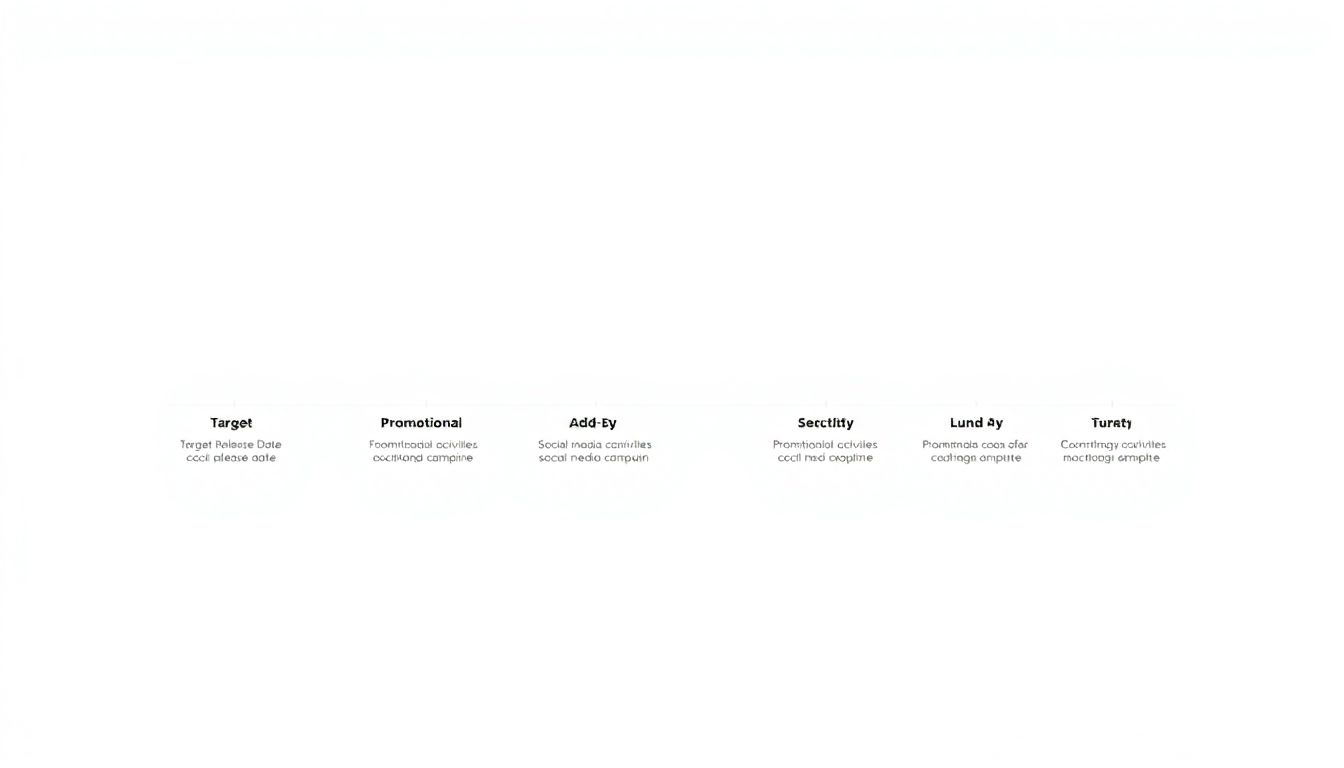Launching a book can feel overwhelming—especially with so many choices about how to share your masterpiece with the world. It’s completely understandable to feel unsure about which steps to prioritize to make your launch successful.
The good news is, by following some simple, practical strategies, you can rock your book launch without pulling your hair out. If you keep reading, you’ll find clear steps to get your book seen, attract readers, and build lasting excitement.
Here’s a quick rundown of exactly what we’ll cover in each step.
Key Takeaways
- Choose a launch strategy tailored to your genre (social platforms for fiction, podcasts or webinars for non-fiction).
- Set clear, realistic, and measurable goals like sales numbers or positive reviews, and track your progress.
- Define your ideal reader to effectively shape your promotional efforts and pick relevant marketing platforms.
- Create a detailed launch timeline, scheduling strategic promotion activities well before your release.
- Select an ideal launch day with high reader activity, avoiding dates overshadowed by holidays or major events.
- Use genuine, engaging social media content, early reviewers, and influencer collaborations to build anticipation.
- Stay connected post-launch—monitor reviews, track book sales, and maintain audience engagement through regular communication.

Step 1: Choose the Right Book Launch Strategy
Picking the right book launch strategy can really set the stage for your entire publishing journey. Whether you’re self-publishing or going through a publisher, your launch determines how much initial buzz your book gets. For instance, a personalized launch strategy that includes reaching out to book reviewers and running targeted ads on social media platforms can lead to stronger early sales.
Think about your genre and format when choosing a strategy. Fiction usually benefits from promotional giveaways and influencer recommendations, while non-fiction books often find an audience through podcasts, webinars, and educational content marketing. For example, if you’re making a graphic novel, exploring targeted strategies on how to publish a graphic novel effectively can open up opportunities you might otherwise overlook.
You also want to choose your launch channels based on real-world data. Amazon sells over half of all print books, making it crucial for visibility, while independent bookstores still hold big appeal for in-person engagement and community support.
Step 2: Set Clear Goals for Your Book Launch
You can’t measure success if you don’t know what you’re aiming for, right? So start by laying out clear, specific goals for your book launch. Are you trying to hit bestseller lists, aiming to get 100 positive reviews, or looking to sell a certain number of books in the first month? Decide those targets first because they’ll help shape every decision you make afterward.
Make your goals specific, measurable, and attainable. For instance, instead of simply aiming to “boost sales,” go for something concrete—like selling 500 copies now, knowing you can ramp up to thousands down the line. If you’re new to this, take heart—many first-time authors find hitting initial modest goals better boosts their confidence and direction. If you’re unsure about realistic goals, understanding aspects like how much authors make from Amazon KDP can give you a clearer picture of what’s achievable.
Once you set your goals, make sure you have a tracking system. It can be as simple as a spreadsheet, but tools like Book Report or Publisher Rocket can help track your numbers on platforms you use.
Step 3: Identify Your Ideal Readers
No matter how amazing your book, you aren’t writing for absolutely everyone. Identifying and understanding your ideal reader helps focus your marketing, helps you pick the best platforms for promotion, and makes your launch efficient. Imagine sitting with your ideal reader and having coffee—think about their interests, favorite authors, social media habits, even demographics like age and hobbies.
For instance, if you’re publishing a romance novel, readers often frequent platforms like Instagram and BookTok, while mystery or thriller fans might congregate around Goodreads or specific Facebook groups. And if you’re targeting younger readers, funny and relatable content like these funny writing prompts for kids could work wonders to draw attention.
A handy tip is creating a reader avatar—a fictional representation offering specifics like age, occupation, lifestyle, and reading habits. You can use this to craft marketing messages that hit home. Once you pinpoint your readers, marketing feels less random and more comfortable, helping your book resonate with the people it’s meant to reach.

Step 4: Create a Timeline for Your Launch Activities
Creating a clear timeline is key to keeping yourself sane during a launch—it helps you avoid last-minute panic (trust me, we’ve all been there).
Start by marking your target release date, and then work backward, scheduling your promotional tasks and deadlines.
Two to three months out, you can start reaching out to reviewers and influencers.
About one month before launch, ramp up your social media game, create engaging posts, tease your book’s cover, and share intriguing snippets—maybe even some fun winter-themed writing prompts if the timing fits to engage people creatively.
Two weeks before launch, finalize your email marketing sequence with reminders, countdown emails, and exclusive sneak peeks.
Keep your immediate pre-launch week focused on confirming your book listing is live, setting up promotional discounts (if any), and double-checking that your website and social profiles reflect the upcoming launch clearly.
Being realistic with timelines saves you headaches—always buffer time for surprises; they’re bound to happen.
Step 5: Select the Best Date for Your Book Release
When you pick a date, think practically, not just symbolically.
Avoid holidays and major events that might overshadow your launch unless your book specifically ties into them (launching a romance around Valentine’s Day does make sense!).
Also, keep an eye out for when your ideal readers might be most active—weekends or early in the week often work best.
If you’re setting your sights on bestseller lists, research their tracking periods and deadlines—this can significantly impact your chances.
Check book sales trends, too—for example, book sales saw about a 1% increase last year, boosted significantly by BookTok and other trends, though print unit sales dipped slightly in early 2025 compared to last year (according to Publishers Weekly).
Piggybacking off those trends helps position your launch strategically.
Step 6: Build Buzz with Social Media and Promotional Content
You’re launching into a crowded market, so social media is your new best friend.
Be sure not to oversell—be authentic, funny, conversational, or educational depending on your book genre.
Platforms matter—Instagram and TikTok (think BookTok) suit fiction and YA genre perfectly, whereas LinkedIn works wonders for professional non-fiction.
Short videos showcasing your writing process, fun author Q&As, or teasing enticing story snippets can create genuine buzz.
You could create Instagram Stories asking followers their opinions on a book cover design (great interactive content), or use polls and quizzes to boost reader engagement pre-launch.
Step 7: Connect With Influencers and Early Reviewers
Influencers and reviewers help you get discovered—it’s a bit like borrowing someone else’s audience.
Don’t just shoot for the biggest names—you’ll actually have better luck with micro-influencers and dedicated, niche book reviewers.
Reach out professionally but warmly, offering free digital or print ARCs (Advance Reader Copies) in exchange for an honest review or post.
Platforms like NetGalley can help distribute early copies efficiently, or you can even personally invite loyal newsletter subscribers or active followers to become early readers.
Building genuine relationships is key here—appreciate their feedback, even if it’s not all glowing.
Step 8: Plan Effective Email Marketing Campaigns
Emails might feel old-school, but they convert incredibly well for book sales.
Create a series—not just one random announcement email.
For instance, introduce your book a month before launch, then send a cover reveal a couple of weeks out, and finally share a direct purchase link on launch day.
Think of juicy incentives to get readers subscribed beforehand, like offering a free sample chapter or bonus short story.
Platforms like Mailchimp or ConvertKit simplify campaign creation and automate sends, saving you valuable time (and sanity!).
Step 9: Run Contests and Book Giveaways
Who doesn’t love free stuff?
Running giveaways can really boost your visibility fast, especially on social media.
Consider hosting a giveaway through tools like Rafflecopter or Gleam, allowing readers to enter by following your social channels or joining your newsletter.
Make prizes attractive but affordable—signed copies, swag related to your book’s themes, or personalized goodies.
Contests can build engagement right before your launch date, giving momentum as you publish.
Step 10: Organize a Book Launch Event
No, it doesn’t need to be some grand gala.
An intimate bookstore reading or even a virtual Zoom event counts, too.
Find a suitable venue—the local bookshop, library, café—or go digital and host via Facebook Live or Instagram to reach a broader audience.
Include Q&A sessions, short readings, behind-the-scenes stories, and maybe even invite fellow authors for panel discussions.
Local independent bookstores can hugely boost in-person discoverability, as highlighted by the consistent community support they enjoy (see more about independent bookstores’ impact from American Booksellers Association).
Step 11: Track Sales and Reviews After Launch
Your job isn’t over after launch day—now the feedback begins.
Stay on top of sales numbers using tools like Amazon’s KDP Dashboard or broad tracking software like Publisher Rocket to understand what’s working right away.
Amazon dominates roughly half of U.S. printed book sales and more than 80% of eBook sales, underscoring the importance of monitoring this platform specifically (source: AuthorImprints).
Watch your reviews closely too—engage occasionally to thank readers for positive feedback or professionally address any criticism.
Both numbers and reader impressions help guide your next steps post-launch.
Step 12: Follow Up and Keep Your Audience Engaged
Once you launch your book, staying in touch with your audience is a key factor in sustained success.
Continue email newsletters, sharing ongoing behind-the-scenes content, book updates, or how you’re planning your next project.
Maintain social media interaction by asking questions, responding to comments, or introducing fun writing challenges like these realistic fiction writing prompts to keep your community engaged creatively.
When you genuinely communicate, the relationship stays strong, building loyal fans ready to support your continued publishing journey.
FAQs
Effective book launch strategies include building interest through social media promotion, engaging influencers for reviews, hosting giveaways, and holding launch events. Choosing specific reader demographics and setting clear, measurable launch goals improves the likelihood for successful sales.
The ideal date to release a book depends on factors like genre, target market, and reader habits. Many authors avoid major holidays or crowded release weeks, selecting dates that align well with readers’ availability and purchasing trends in their genre.
Effective email marketing includes creating a clear launch announcement, sharing exclusive content or offers, sending regular updates, and including a strong call-to-action in every email. Segment your mailing list to target specific interests and encourage reader engagement and sales.
Connecting with influencers and reviewers boosts your book’s visibility and credibility. Influencers provide valuable exposure to wider audiences, while positive early reviews build reader trust, influencing purchasing decisions significantly in the book-selling market.
